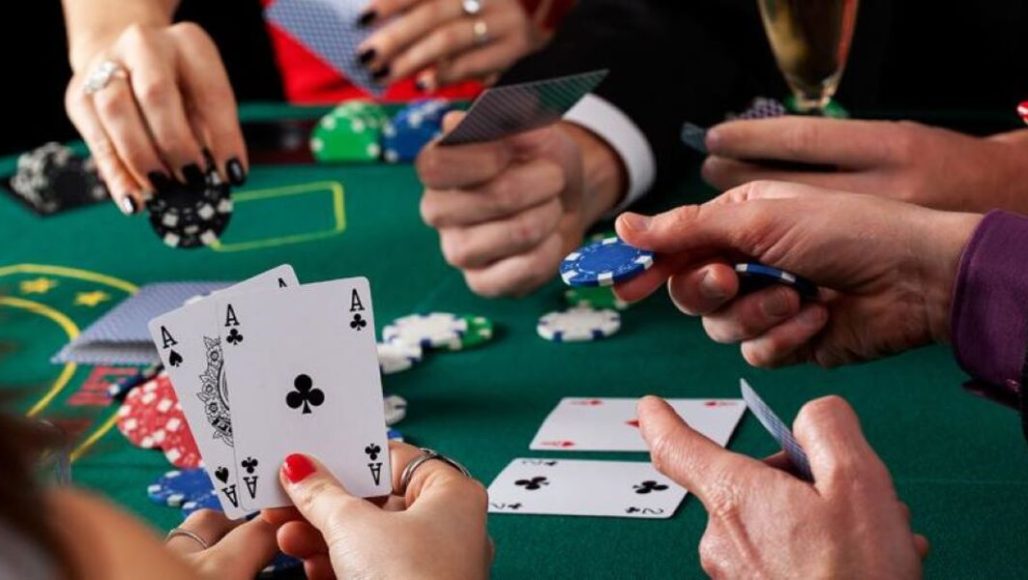Types of Poker Players: Understanding Table Dynamics

Poker is a game of skill, strategy, and psychological warfare, unlike video poker where you play against a machine; in live poker, every hand dealt is a new opportunity, every player a new challenge. To excel in this game, one must not only master the rules and strategies but also understand the different types of poker players you’re likely to encounter at the table. This knowledge is vital, as it can significantly influence your decision-making process and ultimately, your success.
The Importance of Recognizing Different Types of Poker Players

When you sit down at a poker table, you’re not just playing the cards—you’re playing the players, and understanding the types of poker players, much like understanding poker positions, can give you a strategic edge. Each player type has its own set of tendencies, strengths, and weaknesses, which can be exploited if recognized early.
Why is this crucial? Because poker is as much about psychology as it is about the cards in your hand. Identifying a player’s type, just as with knowing the importance of your position at the table, can help you anticipate their moves, adjust your strategy, and increase your chances of winning.
Let’s dive into the most common types of poker players you’re likely to encounter.
1. The Aggressive Player
Aggressive players are the most feared at any poker table. They bet and raise often, forcing their opponents into tough decisions. This player type is characterized by:
- High Bet Frequency: They are often seen betting on almost every hand.
- Pressure Tactics: They push other players out of the game by making it expensive to stay in.
- Bluffing: These players are more likely to bluff, leveraging their aggressive style to intimidate others.
While aggressive players can dominate the table, they are also prone to significant losses when they encounter resistance or someone who calls their bluffs.
2. The Tight Player
Tight players are the exact opposite of aggressive players. They play very few hands and only enter the pot when they have a strong one. Key characteristics include:
- Selective Hand Play: They wait for premium hands like high pairs or suited connectors.
- Cautious Betting: They are less likely to bet unless they have a strong hand.
- Low Risk: These players avoid high-risk situations, preferring to fold rather than chase draws.
Tight players are generally harder to read because they enter fewer pots, but when they do, they usually have a solid hand.
3. The Loose Player
Loose players are more liberal with their hand selection. They’ll play a wide range of hands, often regardless of their strength. Key traits include:
- Frequent Hand Participation: They are involved in many pots, regardless of their hand’s quality.
- Unpredictability: Their wide range of hands makes them harder to put on a specific hand.
- Potential for Big Wins or Losses: Because they play so many hands, they can either win big by catching lucky draws or lose big due to poor hand selection.
Loose players can be challenging to deal with because their unpredictable style can lead to surprising outcomes.
4. The Passive Player
Passive players are often the easiest to play against. They prefer to check and call rather than bet or raise. Their characteristics include:
- Minimal Betting: They rarely bet or raise, often opting to call instead.
- Avoidance of Conflict: These players shy away from confrontations, preferring to stay in the background.
- Weakness Exploitation: Because they don’t bet often, other players can bully them into folding.
Passive players are often seen as weak, but this can be deceptive. They might be waiting for a strong hand to trap an aggressive opponent.
5. The OMC (Old Man Coffee)
One of the more specific types of poker players you’ll encounter, especially in live games, is the OMC. But what is OMC in poker? The term refers to an older, usually conservative player who takes a traditional and cautious approach to the game.
- Extremely Tight: OMCs are known for playing only the strongest hands.
- Predictable: Their play style is consistent, with little variation.
- Risk-Averse: They avoid bluffing and rarely take risks unless they’re holding the nuts.
Understanding what OMC in poker means can help you adjust your strategy when facing this type of player. They are typically not very aggressive, but their disciplined approach means they are unlikely to lose big. However, they are also not likely to win big without a strong hand.
6. The Balanced Player
A balanced player is one who adjusts their style depending on the situation. They can be aggressive or passive, tight or loose, depending on the dynamics at the table. Characteristics include:
- Adaptive: They change their strategy based on their opponents and the game state.
- Unpredictable: Their ability to switch styles makes them difficult to read.
- Strategic Depth: These players think several moves ahead, often outmaneuvering less experienced players.
Balanced players are among the most challenging to play against because they keep you guessing and can adjust to counter any strategy.
7. The Maniac
Maniacs are the wild cards at the table. They play with reckless abandon, betting and raising with almost any hand. Their characteristics include:
- High Volatility: They can either amass huge chip stacks or bust out quickly.
- Constant Pressure: They put constant pressure on other players with relentless betting.
- Unpredictability: Their unpredictable nature makes them difficult to play against, but they are also prone to significant losses.
Maniacs can be frustrating to deal with, but patient players can capitalize on their reckless behavior.
8. The Calling Station
Calling stations are the players who love to see the showdown. They call almost any bet, often without considering the strength of their hand. Key traits include:
- Frequent Calls: They are involved in many hands, calling almost every bet.
- Limited Folding: These players are reluctant to fold, even with weak hands.
- Easy to Exploit: Because they call so often, it’s easy to value-bet against them.
Calling stations can be profitable to play against if you have a strong hand, as they will often pay you off.
The Statistical Breakdown
To give you a clearer picture, let’s break down these player types using some data:
| Type of Player | Hand Selection (%) | Betting Frequency (%) | Winning Frequency (%) |
|---|---|---|---|
| Aggressive | 25% | 70% | 55% |
| Tight | 10% | 30% | 60% |
| Loose | 50% | 40% | 40% |
| Passive | 20% | 20% | 30% |
| OMC | 5% | 10% | 50% |
| Balanced | 30% | 50% | 65% |
| Maniac | 60% | 80% | 35% |
| Calling Station | 40% | 15% | 25% |
Understanding OMC Poker Meaning

The term “OMC” in poker, short for “Old Man Coffee,” has become a staple in the poker community. Originally, it referred to an older gentleman sipping coffee while playing an extremely tight and predictable game. Over time, it has evolved into a broader stereotype encompassing any player who fits the cautious, risk-averse profile typically associated with OMCs.
Why is this important? Understanding the OMC poker meaning can help you adjust your strategy against these players. Since they are typically very conservative, you can exploit their reluctance to bet by applying pressure with well-timed bluffs or stealing blinds. However, be mindful of the rake in poker, as it can chip away at your profits, especially when you’re trying to extract value from such cautious opponents.
Conclusion
Understanding the different types of poker players is essential for anyone serious about improving their game. Whether you’re facing an aggressive bluffer, a tight conservative, or an unpredictable maniac, recognizing these styles can give you a significant advantage at the table.
Moreover, knowing what is OMC in poker and the nuances of each player type will allow you to tailor your strategy accordingly, increasing your chances of success. The key is to stay observant, adaptable, and always one step ahead of your opponents.
Remember, poker is not just a game of cards—it’s a game of people. And in this game, understanding your opponents is half the battle.
FAQ
The main types of poker players include Aggressive Players, Tight Players, Loose Players, Passive Players, OMC (Old Man Coffee) Players, Balanced Players, Maniacs, and Calling Stations. Each type has its own unique playing style and strategy.
OMC in poker stands for “Old Man Coffee.” It refers to a player, typically an older individual, who plays a very tight and conservative game, often only entering pots with very strong hands. The term has evolved to describe any player who adopts a highly cautious, risk-averse approach.
Recognizing different player types allows you to anticipate their moves, exploit their weaknesses, and adjust your strategy accordingly. For example, you might bluff more against a passive player or be more cautious against a tight player.
A tight player only plays a small range of strong hands and avoids high-risk situations, whereas a loose player participates in a wide range of hands, regardless of their strength, making them more unpredictable but also more prone to mistakes.
When facing an aggressive player, it’s important to stay patient and avoid being intimidated by their frequent bets and raises. You can wait for strong hands and then trap them by allowing them to bet into you or occasionally bluff if you believe they will fold to pressure.
A balanced player is one who can adapt their strategy based on the game dynamics and their opponents. They can be aggressive or passive, tight or loose, depending on what the situation demands. This adaptability makes them difficult to read and challenging to play against.
Yes, passive players are generally easier to exploit because they tend to call rather than bet or raise, making them susceptible to being bullied out of pots. However, be cautious as they may also be setting traps with strong hands.
When playing against a maniac, it’s essential to be patient and let them make mistakes. Maniacs often bet and raise with weak hands, so wait for strong hands and then capitalize on their reckless behavior.
OMC players are usually characterized by their extremely tight and predictable play style. They often only enter pots with premium hands and are reluctant to take risks. They might also exhibit conservative betting patterns and a general aversion to bluffing.